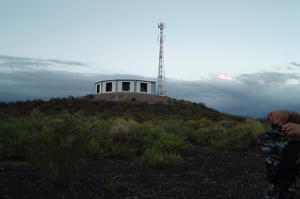|
||
      |
Next Generation
Two cosmic-ray detectors are better than one
From the outside, the Pierre Auger Observatory doesn’t look all that remarkable: a collection of white plastic water tanks stretching across Argentina’s vast Pampa Amarilla, surrounding what resembles a radio tower and an electric power substation. But the $50 million structure, now nearing completion, represents a scientific frontier. The largest cosmic-ray detector ever built, it will probe the universe’s fastest atomic nuclei, a scientific bafflement for nearly 70 years. “We want to know where they come from and what they are,” says Angela Olinto, chair and associate professor of Astronomy & Astrophysics and one of 370 researchers in the Auger Observatory’s 16-country collaboration. (Nobel laureate and professor emeritus James Cronin, SM’53, PhD’55, helped start the project in the 1990s.)

With as much as 100 million times more energy than the world’s most powerful particle accelerators can replicate, high-energy cosmic rays bombard Earth’s atmosphere, dispersing into invisible showers of billions of secondary particles. Likely made up of protons and other charged subatomic fragments, cosmic rays may originate in black holes or other galaxies, or even “from extra dimensions.” To find out, the observatory combines two techniques. Spaced at one-mile intervals, 1,600 water tanks will produce light emissions each time they intercept a cosmic-ray particle. Meanwhile, four fluorescent telescopes will pick up ultraviolet emissions from cosmic rays in the atmosphere. “So we can see the shower when it hits the ground and also how it develops in the atmosphere,” Olinto says. The observatory has been gathering information for a year already. “These are the highest-energy events we’ve ever seen in the universe.”